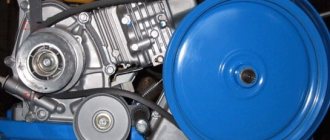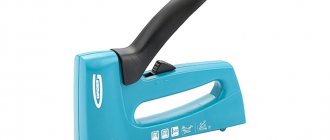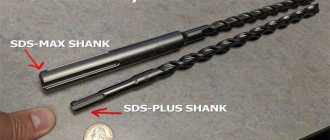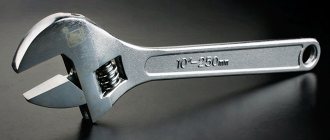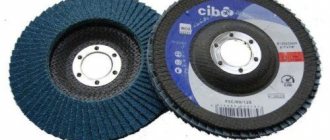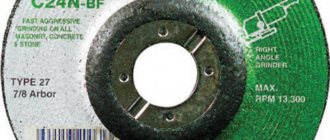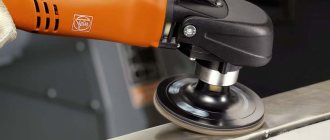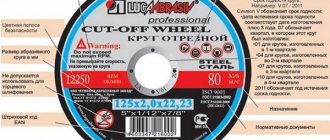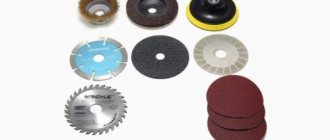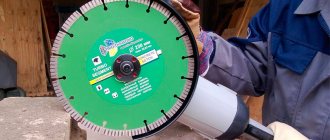Scope of application of abrasive grinding wheels
Polishing any elements not only makes them more attractive in appearance, but is also often a necessity from a technical point of view. In everyday life, elements of interior items are often subjected to this process, and in industrial production - parts of various machines, machine tools and other mechanisms.
For moving parts, polishing is extremely important: individual parts must be well fitted and smoothed to minimize friction. It is worth noting that a variety of materials are subjected to grinding - metal, stone, plastic, wood. Abrasive wheels are also actively used in a variety of sharpening machines.
Abrasive wheels can vary in shape as they are used for different purposes. In addition to smoothing the surface, metal parts often need to be cleaned of rust. It is almost impossible to implement this task without special circles. Using removable attachments for a grinding machine, you can make recesses and grooves of varying complexity in various materials, including non-ferrous metals, ornamental stone, concrete walls, soft alloys.
Abrasive wheels are very popular among jewelers, for whom polishing items made of precious metals is the main part of their work. Stone craftsmen who work with ornamental minerals and semi-precious stones also use this tool.
Sanding attachment for drill
There are special types of grinding attachments installed on the drill. They are actively used during repair or finishing work (for example, for cleaning the surface of walls before laying tiles or applying plaster compositions). Some sanding wheels are great for removing old paint from plumbing fixtures, cleaning pipes from corrosion, and other similar jobs.
Where are abrasive grinding wheels useful?
Discs that can be used in an angle grinder are considered universal, because they can be used to process almost any surface. Thanks to such discs, you can cut, peel, clean and grind a variety of products.
Types of abrasive discs can be divided into 2 groups:
- Sanding group.
- Cutting equipment.
Grinding wheels include products that remove rust, help to peel, grind, polish, and clean a part. In order to cut different materials, exceptional cutting discs are used.
Types of Grinding Wheels
To properly process a part, it is necessary to determine the type of grinding. This will allow you to choose the right abrasive attachments. The main selection criteria are the material of the workpiece and the nature of the impact on its surface.
Thus, grinding wheels with a straight or annular profile are widely used in everyday life and on small machines for grinding metals and sharpening operations performed by their end surface. These wheels are relevant when working with glass, porcelain, and stone (here you can also use flat attachments with one- or two-sided grooves, which are also convenient when carrying out grinding work).
Conical grinding wheel
The most common are conical circles, which can be either double-sided or regular. They can be used for all of the above work for surface treatment of parts with a plane. They can also be used to make holes in almost any material.
For processing many parts, the best options include a grinding cup wheel and a wheel with disc attachments (most often they have all-metal attachments and diamond coating). The cup wheel resembles a straight profile tool with a conical undercut. The main difference is that the end is located at a right angle to the side plane.
Example of cup abrasive wheels
The range of abrasive wheels by type of abrasive is quite wide. In addition to the previously mentioned diamond coating, electrocorundum is widely used. Solid nozzles are made using electrocorundum. Most often they do not have a base and a pressed core.
Circles made of silicon carbide are also in demand. The latter are divided into two types: black and green (the nozzles have the corresponding color). Green is more fragile.
CBN is a high-strength abrasive. This material is based on cubic boron nitride. In terms of performance properties, it is not inferior to diamond, while CBN has a higher level of heat resistance.
Electrocorundum circle
What kind of circles are there for emery - another educational program
Many people have an emery machine at home - an electric machine equipped with grinding wheels. Most often, something is sharpened or polished using emery. There are a lot of abrasive grinding wheels on sale; in addition to them, it is convenient to use diamond grinding wheels in everyday life. However, for initial processing, for rough processing of metal, it is better to use abrasive wheels. Let's look at the classification of sanding wheels, what they are and where they are used.
White circles - they are made of electrocorundum 25A
The most popular wheels, since they are designed for processing non-hard metals, are perfect for the home. Sharpen knives, axes, scissors, process ordinary steel (corners, etc.) - such a circle will work just fine. Huge selection of sizes and mounting holes:
The marking of electrocorundum 25A is most often white. Sometimes manufacturers add a coloring element, which can result in the circle being blue or orange. When turning ordinary metal on such a wheel, a very high-quality sharpening is obtained, since the composition of the wheel itself is soft, the temperature during friction is low, so blue scale does not appear on the metal, and since there is none, the metal retains its properties perfectly.
This primarily applies to knives and other cutting objects, since it is very important not to overheat the metal when sharpening. So an alumina grinding wheel is a great choice for your home.
The sizes of circles are different for different machines. The fit is most often 32 mm - if you buy a wheel for home emery. The most common circle sizes are 125, 150, 175 and 200 mm in diameter, fit 32 mm and thickness 10, 16, 20, 25 mm. As you know, sandpapers for home use come in different sizes, which is why the wheels come in several sizes.
Green circles - made of silicon carbide 64C
Green wheels are intended for processing tool steel and hard alloys (for example, brazing on drill bits for a rotary hammer).
The material is more resistant to abrasion, the temperature during sharpening is high, so if you decide to sharpen a kitchen knife with this circle, you will probably ruin the knife, since scale will appear on the blade instantly.
Therefore, such a wheel is used only for turning tools made of tool steel (R6M6, R18, steel with the addition of cobalt, also hard alloys VK8, T5K10, T15K6). Of course, sharpening carbide is also not very convenient; you need to use the finest grain of the wheel, but it is best, of course, to sharpen carbide with diamond sharpening wheels.
The marking of the circle is 64C, the dimensions are the same as for electrocorundum.
It is worth noting that in addition to small wheels for everyday use, large-diameter grinding wheels are produced and placed on large machines. The fit of such circles is 76 mm, 127 mm and 203 mm.
Diameters 250, 300, 350 and 400 mm. Electrocorundum and silicon carbide.
These are large, heavy and expensive wheels to produce. For example, here I am holding a circle 64c 400*40*127 25CM - photo:
What kind of “grain” is there?
Many who buy grinding wheels for emery do not even know how the grit is marked. I think this point also needs to be covered in more detail.
So, the grinding wheel grain is 8, 12, 16, 25, 40-N.
8 is the smallest, 40 is the largest.
In addition to the numbers, you can also see the letters SM - this means a medium-soft circle, the most common because it is not very expensive and endures quite well. A little less often you can find ST grain on sale - medium-hard, its cost is noticeably higher, however, the abrasion resistance is much higher.
For precise sharpening, of course, it is better to take a fine grain, 12 or 16. Often they buy wheels for sharpening skates from us, these are 150 * 8 * 32 12 CM - a wheel with a diameter of 150 mm, thickness only 8 mm, fit 32 mm, fine grain, allows for sharpening just perfect.
For example, to install an emery wheel on a 150 mm machine, it is best to buy one 150*20*32 25 CM - a standard wheel for emery with a diameter of 150 mm, fit 32 mm, wheel width 20 mm. Grit 25 - medium, suitable for sharpening both small tools (knives, scissors) and large ones - axes. SM - a standard medium-soft circle for household use is also suitable. Such a circle costs about 120 rubles.
Among the manufacturers, I recommend grinding wheels produced in the city of Volzhsk - excellent quality (the wheels do not fall apart and last for quite a long time), low price, delivery by transport companies throughout Russia.
Another note: A great screwdriver for gifts and for work. Kraftul is a proven company.
Vulcanite and bakelite grinding wheels
Diamond coating is quite expensive, so it is applied in a very thin layer to a metal base. Abrasive wheels with less strength are formed in a different way. Often, for this purpose, a binder ceramic composition is used, where the main components are materials of inorganic origin (quartz, clay, etc.). Highly ground, these binders are added to the selected abrasive when forming the wheel, providing the finished product with increased rigidity, but also corresponding brittleness.
Bakelite circles
Bakelite nozzles are in great demand on the market. They owe their name to the main filler – bakelite (artificial resin). This binding component gives the circle elasticity and a kind of elasticity, but at the same time wear resistance is reduced as a result of weaker fixation of the grains (compared to a rigid ceramic base).
It is important not to forget that a rigid base of high hardness can lead to overheating of the metal being ground and, accordingly, burnout of the surface of the processed element. Bakelite nozzles do not have this drawback. They are much softer, so they heat the metal very little and are capable of self-sharpening when processing a part.
Wheels on vulcanite bond
The grinding wheel with vulcanite binder is even softer. Here the main abrasive element is synthetic heat-treated rubber. In other words, vulcanization is used in the production of such grinding attachments, which is reflected in their name. Vulcanite wheels have a higher cost compared to ceramic abrasives. However, despite the increased elasticity, their wear resistance is beyond praise.
Selecting a grinding wheel
The main requirement for an abrasive attachment concerns its hardness. The hardness of the nozzle must be higher than the hardness of the workpiece. At the same time, it is undesirable for these parameters to differ greatly, otherwise the likelihood of overheating of the treated surface increases. One of the most important criteria when selecting an abrasive is its grain size.
Large fractions of ceramic or rubber wheels are not suitable for working with soft materials. Fine grains are only suitable for polishing. Often, fine-grained abrasives are applied to cutting discs and disc-shaped metal attachments. A fiber disc can provide a glossy surface. If its nozzle is softer than the workpiece, the processing result will be good, but the wear of the tool will also be very severe.
Fiber grinding wheel
When processing large surfaces, preference should be given to grinding wheels of large diameter: a small wheel will make much more revolutions, so it will also wear out faster. Disc and cup grinding wheels are selected according to a similar principle. For example, for cutting small-sized ornamental stones, a nozzle with a small diameter is sufficient; for processing marble slabs of impressive size, you will need a cylindrical cup wheel with a large diameter.

